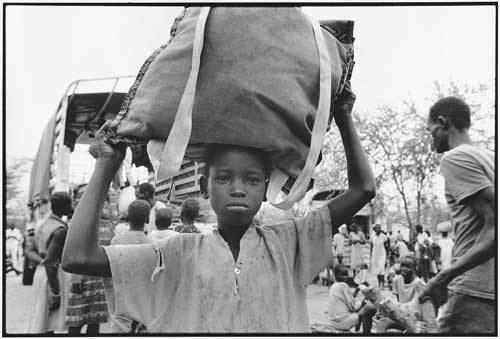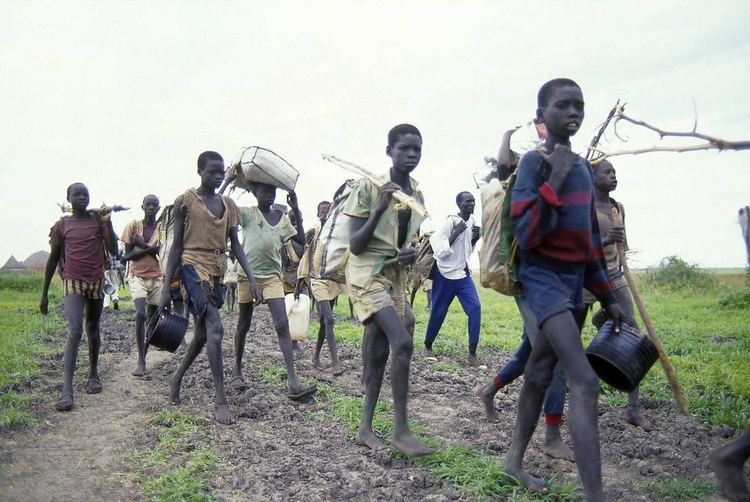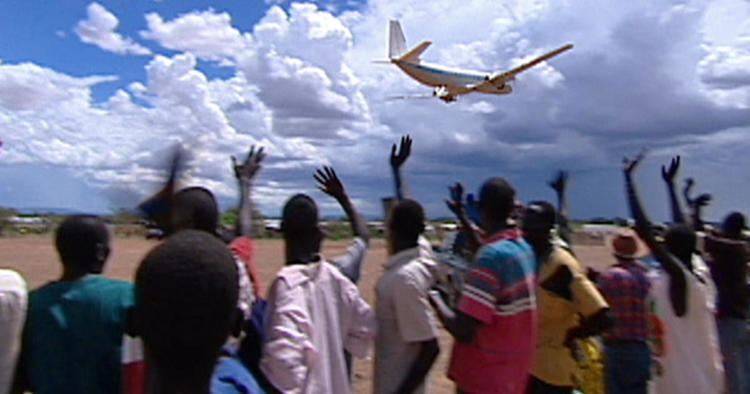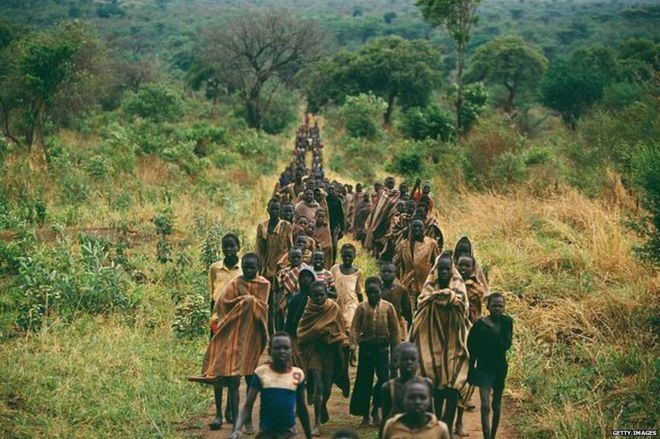 | ||
Lost Boys of Sudan were over 20,000 boys of the Nuer and Dinka ethnic groups who were displaced or orphaned during the Second Sudanese Civil War (1983–2005); about 2.5 million were killed and millions were displaced. The name "Lost Boys of Sudan" was colloquially used by aid workers in the refugee camps where the boys resided in Africa. The term was revived, as children fled the post-independence violence of South Sudan with Sudan during 2011–13.
Contents
- Roots of the Conflict
- Effects on children
- Flight of the Lost Boys
- Arrival at refugee camps
- Current status and resettlement
- The Lost Girls
- Books films and plays
- References

Roots of the Conflict

The conflict in Sudan between the northern and southern regions had existed since Sudan’s independence from Britain in the 1950s. It was rooted in economic, cultural, and religious disparities between the north and south. The northern region of the country was primarily Muslim, which contrasted ideologically with the Christian and animist religions that were more prevalent in the south. Although the north had more of the urban centers of the nation, they depended heavily on the natural resources such as oil and minerals that were found in the southern region. The interests of northern business in extracting these resources contrasted the desires of southern farmers to protect and own their own land for agriculture

In 1983, the conflicting division of the population that had led to riots, massacres, protests, resulted in the formation of the Sudanese People’s Liberation Army (SPLA). Civil war began between the SPLA and the existent Sudanese government, which led to numerous attacks on civilians as well as military groups. In many southern rural villages, troops from both sides would wage massive raids, stealing food and killing as many inhabitants as they could. One of the worst instances of this was the Bor massacre, in which 2,000 people were killed.
Effects on children

Most of the boys were orphans separated from their families as a result of the systematic attacks in the southern part of the country. Many avoided capture or death because they were away from their villages tending cattle at the cattle camps (grazing land located near bodies of water where cattle were taken and tended largely by the village children during the dry season) and were able to flee and hide in the dense African bush. Some of the unaccompanied male minors were conscripted by the Southern rebel forces and used as soldiers in the rebel army, while others were handed over to the government by their own families to ensure protection, for food, and under a false impression the child would be attending school.
Flight of the Lost Boys

Motivated by the loss of their parents and their need to find food and safety from the soldiers, an estimated 20,000 boys and girls from rural southern Sudan fled to bordering Ethiopia and Kenya. Most of this travel took place in large groups by foot, and the journeys could be up to thousands of miles on average to the nearest camps. Travel ranged from a span of weeks to two or more years. Often the children traveled with no possessions besides the clothes on their backs. The Boys often depended on the charity of villages as they passed for food, necessities, and treatment of the sick, but most of their travel was in isolated regions with very little infrastructure. Groups of Boys were often organized and led by the oldest boy in the group, who could be an adolescent or young adult but sometimes was as young as ten or twelve years old.
The Lost Boys on this migration were on average extremely malnourished, as food was sourced through donations from villages encountered along the way, hunting, and theft. They were also vulnerable to heat exhaustion, pneumonia, malaria, and other diseases to which they had little means of prevention or treatment. Additionally, attacks on the children by lions, snakes and other wild animals were not uncommon. It is estimated that over half of the young migrants died along their epic journey, due to starvation, dehydration, sickness and disease and attack by wild animals and enemy soldiers. Conditions were made even more dangerous by the SPLA soldiers often attacking boys or forcibly recruiting some as child soldiers. The SPLA estimated that 1,200 boys were recruited from groups of displaced children, although they deny forcing any of them into conflict. Experts say the Lost Boys are the most badly war-traumatized children ever examined.
Arrival at refugee camps
The arrival of the Lost Boys and Girls to the refugee camps in Ethiopia and Kenya was welcomed to various degrees. Providing sufficient food to the camps as hundreds of Boys would arrive together on a regular basis was extremely difficult, and the United Nations High Commission for Refugees and involved non-governmental organizations were often constrained to meet the needs of the population. A problem unique to the story of the Lost Boys is how the age and family structure dynamics of the camps changed with the influx of young people. The Lost Boys came to the camps without guardians or adult supervision. They immediately required housing and schooling, which changed the allocation of resources in the camps. With some of the Boys arriving in the camps at ages as young as 6 or 7, many of the Boys spent the majority of their childhood and adolescence being raised in the camps.
Current status and resettlement
From 1992 to 1996, UNICEF had reunited almost 1200 Lost Boys with their families. However, about 17,000 were still in camps in the area as of 1996.
In 2001, as part of a program established by the United States Government and the United Nations High Commissioner for Refugees (UNHCR), approximately 3800 Lost Boys were allowed to resettle in the United States. They are now scattered over at least 38 cities. Halted after 9/11 for security reasons, the program restarted in 2004. As of 2006, the largest population of Sudanese refugees in the United States is in Omaha, Nebraska, which hosts about 7,000 people. Numerous resettlement agencies, such as Catholic Charities, Lutheran Social Services, the IRC (International Rescue Committee), World Relief and others assisted in the resettlement process. A variety of programs have been initiated to help these displaced people, in areas of education, medical assistance, reconnecting with families in South Sudan and in rebuilding efforts and providing humanitarian aid in Southern Sudan.
Despite the programs intended to facilitate assimilation, many of the Lost Boys still face difficulties in adapting to life in The United States, Canada, or any of the European countries that offered refugee resettlement. Posttraumatic stress, separation from loved ones, cultural isolation, and racism and discrimination against the refugees made assimilation extremely difficult. Studies have discussed a common condition among the Lost Boys of ambiguous loss, which occurs when a person experiences the loss of a family member if they are missing or have been separated, but without the closure of death which allows for mourning and then moving forward. Resettlement to the US made it easier for many of the Lost Boys to reconnect with family members, although it was often difficult to reunite if the Boys were already in the US and the families remained in camps. North and South of Sudan allowing free access to Lost Boys/ Girls and Sudanese Diaspora from around the world to return to their homeland. As a result, many are now returning to South Sudan to pay it forward and help in the rebuilding of their war-torn country and to provide humanitarian aid and support. In January 2011, 99.47% of South Sudanese voted to separate from the north and become an independent nation. Some American former Lost Boys and Girls now hold positions in the current Government of South Sudan.
The Lost Girls
Inequalities between the Lost Boys and Lost Girls was manifested partially in cultural practices of the Dinka and Nuer people. Not unlike many parts of Africa, women were viewed as subordinate to men in families and villages. Male children inherited their parents wealth after their death, and so parents strongly desired having male children, often at the expense of the care of the females. Men were allowed to have multiple wives, and polygamy was expected if the father had no sons by his other wives.
When conflict reached the rural parts of southern Sudan, it impacted girls too. When villages were attacked, girls were raped, and women and small children (boys and girls) were taken to the north to be sold as slaves. When the women and children were trafficked it was extremely difficult for family members to relocate them.
When arriving in the camps in Ethiopia, the boys were placed in boys-only areas of the camp, but according to Sudanese culture, the girls could not be left alone and were placed with surviving family members or adopted by other Sudanese families. Although these family placement practices provided security for the young women, families often exploited the extra pair of hands at home, and the Girls were expected to fulfill numerous domestic responsibilities that were often very tasking or even dangerous. The expectations of domestic work were often preventative of women being able to attend school while in the camps, and even when allowed to attend their housework often kept them behind their male classmates, who had time to study. Girls were abused by their host families, raped by other refugees during activities such as fetching water or food rations, and even occasionally sold as brides for profit.
When the resettlement program to the US was initiated in 1999, one of the requirements was that the children must be orphans. Because these girls had been living in these family units for up to 9–14 years, they were no longer considered orphans, and therefore were not eligible for the resettlement program. As a result, relatively few of the Lost Girls were deemed eligible for the resettlement program to the US. Of the 4,000 Sudanese refugees approved in 2000 to resettle in the US, only 89 were women.
Books, films and plays
There have been a number of books, films and plays about the Lost Boys, including:
